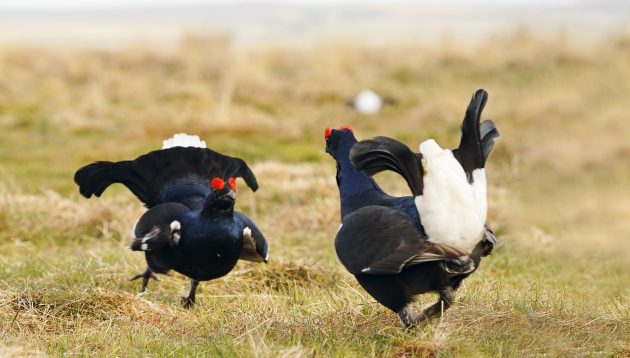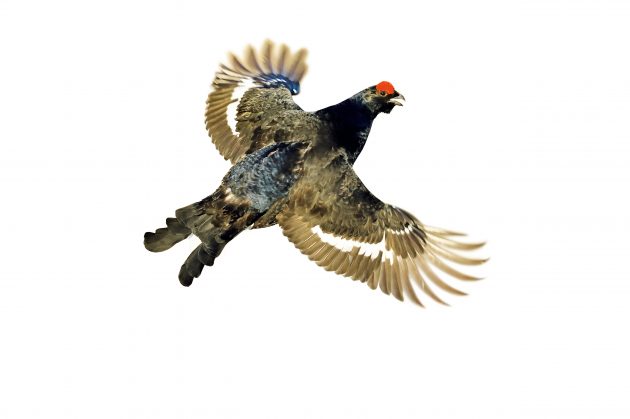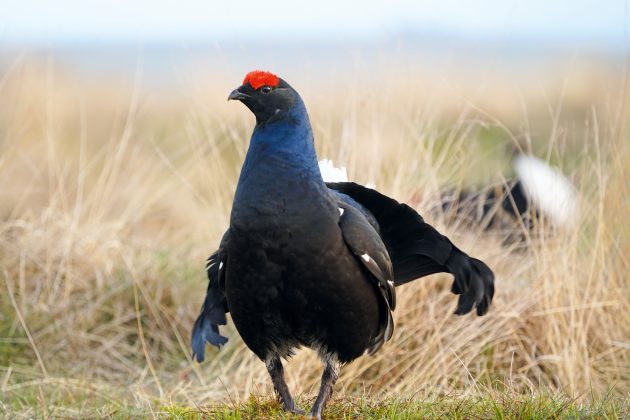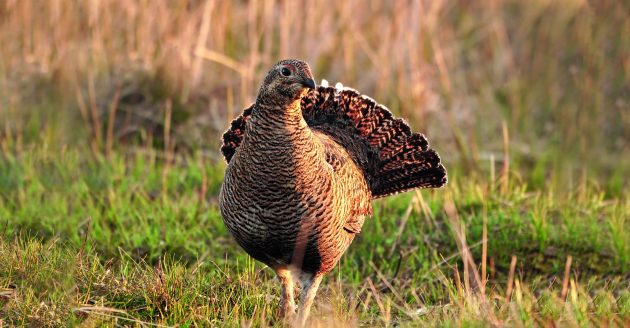The swaggering spectacle of the blackcock lek is an astonishing piece of natural theatre that few are fortunate enough to witness writes Adrian Dangar
My visit to the northern Pennines begins with a magical mystery tour of a grouse moor in Upper Teesdale that is home to a staggering variety of birdlife including the famous blackcock lek. In addition to the ubiquitous red grouse and meadow pipits we see, during the course of just a few hours, dozens of curlew, golden plover, oystercatchers, a merlin and wheatears, all of which breed on the estate. Along with the nests of several rare waders, we are shown one containing four conker-brown kestrel eggs perched precariously on the edge of a sheer cliff, and on the walk home – the icing on the cake of a memorable afternoon – a pair of entwined adders copulating in a sieve bed.
I am part of a small group of conservationists for whom this is not just a visual experience but an educational one too. I am sure most Field readers know that oysters rarely feature on an oystercatcher’s menu, but are you aware that their propensity for stealing the eggs of other birds – along with their striking black-and-white markings – has earned them the sobriquet ‘sky badger’? Or that the gorgeous swirly-speckled gems laid by golden plover are larger in relation to the adult’s size than the eggs of any other wader? Around 230 pairs of breeding curlew return to nest here every spring, and throughout the afternoon the sky has cackled with their beguiling mewing. But although undeniably lovely, it is not curlew we have come to see.

So far, there has been no sign of mysterious black grouse apart from their comma-shaped droppings and an area of paddled ground roughly the size of a tennis court known as a lek, where they have been congregating during the past few weeks to court and mate. By daybreak the following morning all will be revealed, for the northern Pennines represent a stronghold for one of Britain’s few truly endemic birds. “What is wonderful about the lek,” says our host over dinner that evening, “is that it’s so predictable – probably more so than any comparable wildlife experience in this country.” In less than six hours’ time I will see for myself. I can hardly wait, let alone sleep.
According to Patrick Laurie’s informative and beautifully illustrated book The Black Grouse (2012), blackgame once thrived throughout England, Scotland and Wales, and there was even a lek on Wimbledon Common. There were other leks in just about every county in England, including the whole of East Anglia, Hampshire, Kent, Surrey and Wiltshire. Of the species’ value as a table bird there is no doubt. The black grouse (then described as a heath-poult) was in the best of company as far back as 1636 when the first King Charles imposed a ban on the dressing or sale of any ‘venison, red or fallow, or any hare, pheasant, partridge or heath-poult’. The Victorians’ discovery of Scotland as a sporting paradise in the mid-19th century coincided with an appreciation of the species’ sporting value, for a blackcock in full flight can travel even faster and just as high as a January cock pheasant. Huge bags were shot during the second half of the century, including 252 in Staffordshire in 1860 and 247 less than a decade later in Dumfries & Galloway.

However, within a few years of those massive bags the black grouse began a slow and seemingly irreversible decline, which accelerated rapidly as the 20th century advanced. Although it may be tempting for some to blame Victorian and Edwardian sportsmen, temporary reductions to local populations during those eras were counterbalanced by keepers’ efficient suppression of predators. The dramatic fall in numbers has more to do with loss of habitat and traditional farming methods – for example, black grouse love unimproved hay meadows – and the zero-tolerance policy of many foresters during the 1960s and 1970s towards a bird that not only loves to nip the buds off young conifers but is also adept at snapping tender shoots in the process. By the beginning of the 21st century unscrupulous egg collecting and unchecked predation had also contributed to a decline so severe that black grouse are now confined to a few isolated strongholds, of which the northern Pennine range is the most significant in England.
It is no coincidence that the species’ last bastion south of the Scottish border lies within the heart of grouse-shooting country: a landscape where moorland fringes endure, many landowners have established small plantations of mixed woodland on the ghyll sides, and predators are legally and efficiently controlled. In this way driven grouse shooting subsidises not only its rarer cousin but also a host of red-list species, many of which I had seen first-hand during my afternoon on the hill. The importance of keepered land to black grouse is borne out by the GWCT’s finding that 96% of the population inhabit the edge of heather moorland managed primarily for red grouse.
Blackcock reappear on their traditional leks in early spring but the peak of lekking activity takes place between mid-April and mid-May when the greyhen females visit briefly to mate. They commence laying soon afterwards and begin incubation after the last of up to a dozen eggs have been laid in a nest on the ground. During the 27-day incubation, the greyhen only leaves her clutch briefly to feed and deposit droppings known as sitting foil that resemble generous helpings of clotted cream. The chicks hatch in mid-June and for the first two weeks of their life feed entirely on insects, meaning that unseasonably cold or wet weather can have devastating consequences.

Crawling out of bed at 4.15am reminds me of autumn hunting mornings: then, as now, the excitement is palpable. Dawn is a pale smear in the east as we climb into Can-Am Traxters for a cross-country ride to the site of a lek. Nothing could have prepared me for the extraordinary sight that greets us when we suddenly round a corner and find yesterday’s patch of trampled white grass, heather and moss has been transformed into a natural amphitheatre by several magnificent blackcock posturing like Elizabethan courtiers. Bodies puffed up to the size of small turkeys shimmer with a purple-black iridescent glow, and feathery white beacons flutter beneath fans of black, lyre-shaped tail feathers similar to those once used to decorate soldiers’ bonnets. We are close enough to discern elderberry eyes glittering beneath blood-red combs, and strong, short beaks capable of snapping young conifer branches clean in two.
It’s an impressive spectacle, but equally impressive on this breathless spring morning is the all-pervading cacophony emanating from 14 trembling black throats: an unstoppable river of noisy warbling that the cognoscenti refer to as roo-cooing, during which blackcock gulp down air to inflate their necks and create as big a profile as possible. The melodious scene is punctuated by bursts of intense hissing – some would say sneezing, but for me it’s a sound I could imagine coming from the forked tongues of yesterday’s adders, if only they could talk. As a backdrop to the main event, somewhere offstage we can hear skylarks singing merrily and the haunting wails of passing curlew. As far as natural concerts go, this one is simply the best.
Only yards in front of us, the performers appear oblivious to the presence of a mesmerised human audience. Every few seconds a blackcock leaps skyward like a Maasai dancer, trailing his forked black tail; this phenomenon, explains my host, is called flutter jumping. It’s possible to map the boundaries of individual territories through close observation, for each male determinedly defends his own space. This may be a square metre or two for dominant blackcock occupying the centre of the lek, but larger for nervous young pretenders on the periphery, which are distinguished by their sleeker profiles and paler plumage. The older males square up to any rival that encroaches on their territory, but the body language is more courtly indignation than knife in the ribs. I had anticipated raw aggression, so this gentlemanly behaviour is one of many surprising discoveries. Another is the affection in which these birds are held by their protectors, to the extent that some – such as Wonky Tail, Black Bar and Touching Limbs – have even been named.
Blackcock must either have exceptionally sharp eyes or some kind of extra-sensory perception (perhaps both) for shortly before sunrise ripples of excitement wash over the stage several seconds before the appearance of a travelling greyhen. Her arrival at the edge of the lek sets off a frenzy of flutter jumping – whether to gain a better view or demonstrate athletic superiority, it’s hard to tell. Her suitors politely respect her space, but when she enters the territory of a chosen blackcock he circles her deferentially, trailing a wing tip like Sir Francis Drake spreading a cape before his Queen.

Unlike her swaggering counterparts the drab greyhen is shy, unobtrusive and looks remarkably similar to a hen pheasant. She vanishes soon afterwards, but at 6.48am we witness the only successful mating of the morning, which is completed so quickly that I nearly missed it through glancing at my watch. Eight other females have come and gone by then, although they are so adept at melting into the background that it could have been more. Surprisingly, greyhen are far more adventurous than blackcock and have been sighted several times on a futile mission to secure a mate on the North York Moors where none currently exist. Many of us would be overjoyed to see these magnificent birds reintroduced east of the A1 corridor, where so much suitable habitat awaits.
Although they are seldom shot in Britain, blackgame are legal quarry whose sporting potential could contribute to securing a long-term future for a species that currently survives on the coat-tails of moorland managed primarily for grouse shooting. In Finland and other European countries sportsmen pay top dollar to shoot selected blackcock in spring, but having witnessed the incredible spectacle of a blackcock lek – described by a widely travelled member of our group as one of the most impressive wildlife experiences he has ever seen – wildlife tourism springs to mind. Blackcock safaris would not only enable others to enjoy one of nature’s most impressive sights, but they could also contribute to the high cost of moorland conservation and predator control that safeguards their existence in the first place.




